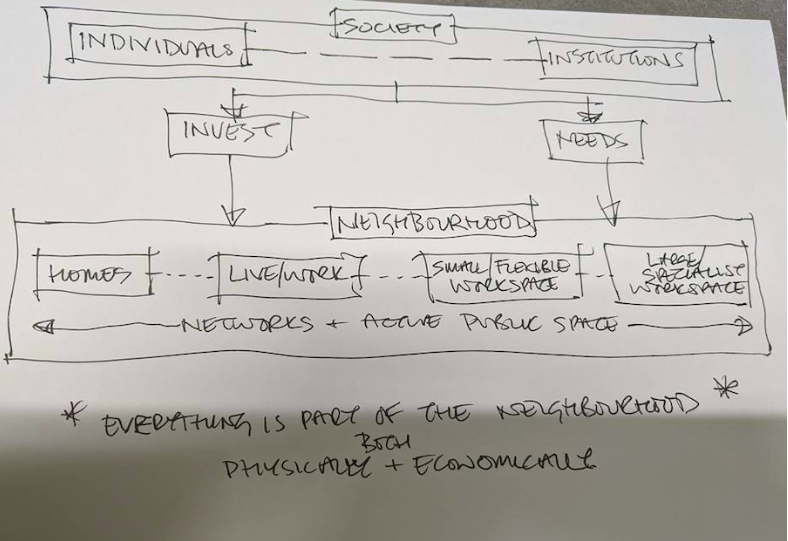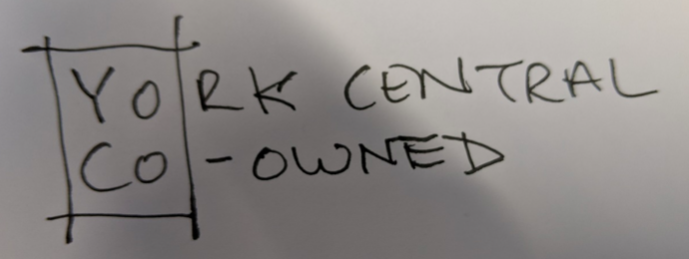28th November 2019
This event followed on from a workshop held as part of York Design Week.
Overview of the emerging model:

Big Idea: Actively reengineer the inequities in York’s economy and society for redistribution of resources to respond to need and desire.
- The connections between people/society and the neighbourhood establish what the economic flows are in each case (someone needing a social rent house, someone needing a workplace for a profitable company)
- The place in which the buildings sit is as important as the buildings as it provides the connections between them, and also connections to the surrounding city
- Homes are not investments, but people can individually or collectively invest in the neighbourhood
- The neighbourhood includes everything including all profit-making stuff
- Institutions and the community-led body can together target specific needs or opportunities which will support the vability economic model (affordable accommodation for staff, visitor accommodation for heritage/theme tourists)
Discussion:
There was a wide-ranging discussion. Here are key themes:-
Examples to look at
- Look at Coin Street on South Bank in London – mix of commercial and residential
- Learn from Lowfield Green, tiny corner or a larger site. It is an indicator for what is possible, it could be a test bed.
- Town also involved in mixed use in Milton Keynes. What is community-led mixed use?
- Good to look at Derwenthorpe, not mixed used or co-owned but constant monitoring in terms of communities. And all monetarised in terms of social value, e.g. film club.
- Yorspace is different from Derwenthorpe, it is resident-led and resident-designed.
- Cambridge University is currently funding accommodation for its workers. 150 hectares, rent is dependent on how much they earn. Is it built for everyone?
- Millennium Village, Allerton Bywater. It was an old mine in the middle of a village and built a new village based on Homezones. Was designed so that no car would go above 10 mph.
- Ebbsfleet, much bigger scheme than York Central. Trying to design communities where they don’t have cars.
- An area purposefully left with holes so it can be developed to enable future development. That would be a real USP. Gaps = the anticipation of change over time.
- Proposing rather than opposing:- instead of a road through the site (to prevent overloading of Holgate Road and Bootham) could we bring a tram / Very Light Rail route through it, linking the Park & Ride to the city centre via all the new housing sites (British Sugar site, Manor School site and York Central) reducing traffic so a through road isn’t needed?
- How to deal with emergency services and deliveries. We must be able to design a pedestrian / cycling surface that can take emergency vehicles. Birmingham City Centre is a good example, large city centre deals with pedestrians and deliveries.
Affordability/Equality/Redistribution
- How to deal with affordability, as part of an intervention in housing inequality?
- Marmalade Lane appears from the promo video painfully white and middle class.
- Need to explore whether/how businesses might invest in affordable houses – one way to ensure the staff they want can live locally
- Do we need to buy land and set up a Community Land Trust in order to create an asset lock?
- It’s not for the faint-hearted.
- But is that socially exclusive? Some people have got multiple jobs and don’t have time to get involved in community-led initiatives.
- Part of this is recognising inequality – of money and time – but that all people are contributing in different ways, which are mutually beneficial.
Relationship between York Central and York City Centre
- What about empty shops on Coney Street? Could there be residential in the city centre? Important not to have two different parts of the city that don’t speak to each other. Could we think of York as having lots of mixed areas that echo each other (rather that different areas that specialise in work / shopping / leisure / living)
- It’s also about the Leeman Road area and community. Edible York has its apple store in Leeman Road and if there was a community kitchen in this area then could make chutney.
National Railway Museum / University of York connections
- NRM – future of the railways. Recruitment and knowledge base of skills. Schools, GP practices, infrastructure. Put health centre near the station.
- NRM – the main decisions are made in London. Really hard to get an interface with them. Has to be about connection, need that otherwise there will be a missing sprocket.
- NRM – it shouldn’t feel like their aims conflict with our aims, how can it be one shared project? Maybe the conversation with NRM should be “how can the community help them achieve their objectives?” Things have moved on since Festival of York Central conversations.
- University of York, VC – need to ensure there aren’t parallel worlds. Does the university provide a bit of a lever there? Needs to be driven together.
A new plan / a new model
- We need to propose not just oppose.
- The other option (to seeking help from NRM/CYC or UoY) is to just to do it. Draw up a new masterplan. Use Power to Change Seed money. Feasibility. Give it credibility. (It’s like wearing a high viz jacket:- no one asks you what you’re doing, you can just get on!)
- Neighbourhood Plans? Ask Locality – Can you do a Neighbourhood Plan in a neighbourhood that doesn’t exist yet?
- An anecdote that might be encouraging – residents for Lowfield Green, they’ve become a community even though they haven’t yet got a neighbourhood. Someone under pressure asked for help, and they all offered it. There is a Cameraderie. Community is not just about bricks and mortar.
- Setting up the model for housing for Lowfield has already been very difficult. But we need to think about how they will think about it in 10 years time.
- Is this just a little bit or the whole site? Things are developing so fast in terms of community-led in the development world, York Central Partnership might just be quite grateful.
Ways forward
- Strong consistency of vision between the discussions tonight and the My York Central conversations. Make the most of this.
- Land position? Ian Gray (Project Director) is focussed on how to set up the overall finance for the scheme, over next 30-50 years. This is designed around deciding what’s wanted on the site and how best to set up funding to enable it.
- Do an alternative plan? Financial plan; spatial plan. Do a pilot proposal for a specific area. Start small but all the concepts are included in the neighbourhood. Use this as a building block. Make it modest and deliverable. Don’t sell it as an enclave, sell it as an approach which can be replicated across the site.
Actions
- Research: Find relevant examples
- Funding: Power to Change; Locality – what funding options? Who is applying for funding? Depends on the funds. Could be a loose model.
- Neighbourhood Plans: Look into whether they might be useful?
- Link with Neighbouring communities: We have contacted Leeman Road Residents Association.
- Set Up Co-Owned York Central Group
- Aaaaand… …we need to think about a name as “Co-Owned Neighbourhoods on York Central” is a bit of a mouthful. Just to kick off discussion:-

Next meeting in 13th January, 6.30-8.30pm, and will be held on York Central itself in the cafeteria at the Cinder Building, off Cinder Lane (YO26 4XD). All vry welcome!